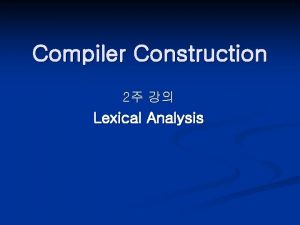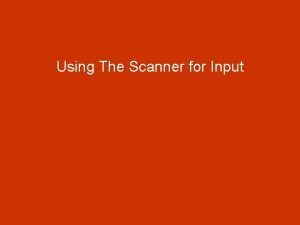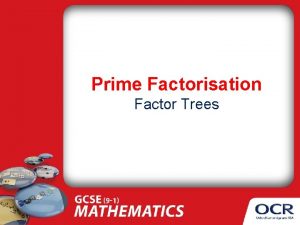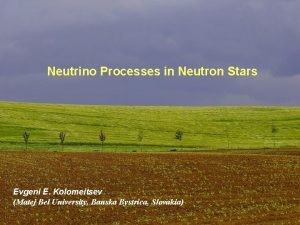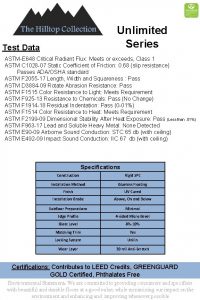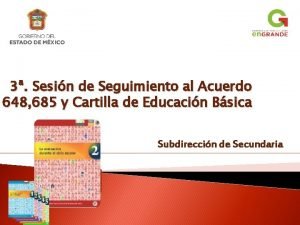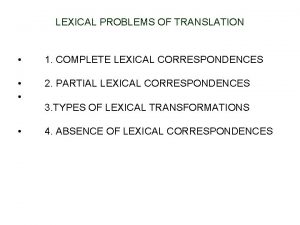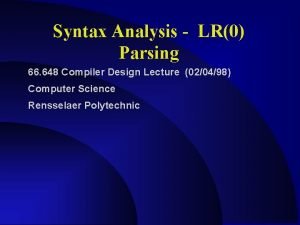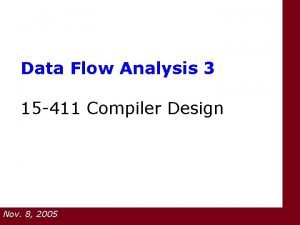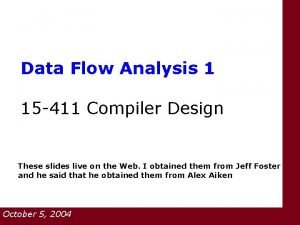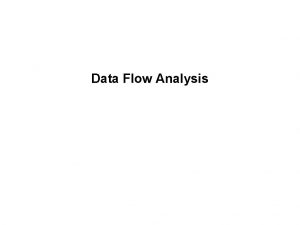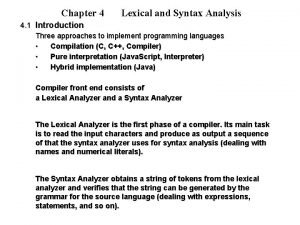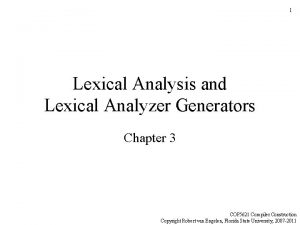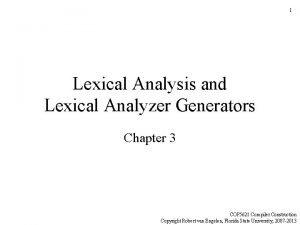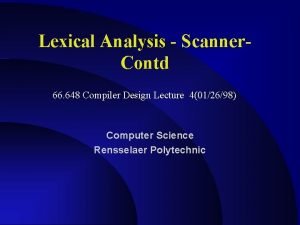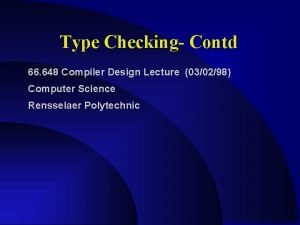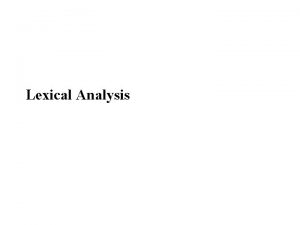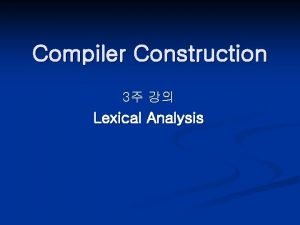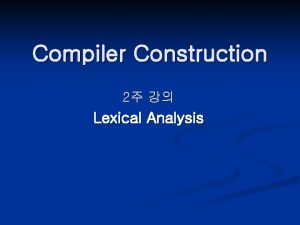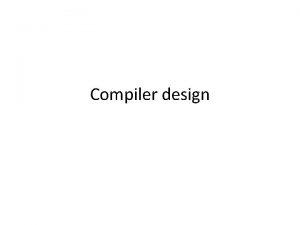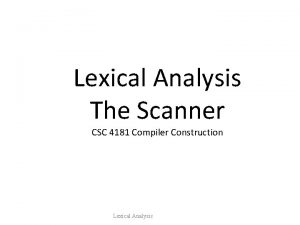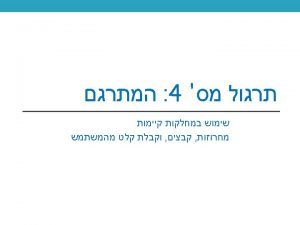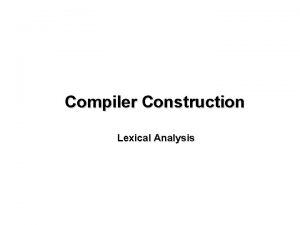Lexical Analysis Scanner Contd 66 648 Compiler Design













![Sample lex program %{ char reserved_word[12][20]; %} %% [a-z]+ { if (lookup(yytext)==-1) { printf(“tok_idt%st%dn”, Sample lex program %{ char reserved_word[12][20]; %} %% [a-z]+ { if (lookup(yytext)==-1) { printf(“tok_idt%st%dn”,](https://slidetodoc.com/presentation_image/deb832db2556406553d7c4668f2ee4ea/image-14.jpg)
![Program Contd “=“ “; ” “(“ “)” “{“ “}” “[“ “]” %% printf(“tok_eqtt%dn”, yylineno); Program Contd “=“ “; ” “(“ “)” “{“ “}” “[“ “]” %% printf(“tok_eqtt%dn”, yylineno);](https://slidetodoc.com/presentation_image/deb832db2556406553d7c4668f2ee4ea/image-15.jpg)



- Slides: 18

Lexical Analysis - Scanner. Contd 66. 648 Compiler Design Lecture 3(01/21/98) Computer Science Rensselaer Polytechnic

Lecture Outline More on Lexical Analyzer l Examples and Algorithms l Administration l

Non-regular Languages Regular Expressions can be used to denote only a fixed number or unspecified number of repetitions. Examples of nonregular languages: 1. The set of all strings of balanced parentheses e. g. . , (()), (()()(())), etc. - nested comments are also nonregular. 2. The set of all palindromes. {wv| v is the reverse of w, w is a string over the alphabet. } 3. Repeating Strings { ww| w a string over the alphabet}.

Examples of Constructing NFA from a reg. expr A NFA for a regular expression can be constructed as follows: 1. There is a single transition labeled with an alphabet. (this includes an epsilon symbol). There are two states, the start state and the final state and one edge/transition. 2. For E 1. E 2, construct a new start state and a new final state. From the start state, add an edge labeled with epsilon to start state of E 1. From the final state of E 1, add an epsilon transition to Start state of E 2.

NFA Counted. Add a transition/edge from the final state of E 2 to the constructed Final state. 3. For E 1|E 2, Construct new start state, new final state. Add a transition from the start state to the start states of E 1 and E 2. These transitions are labeled with epsilon symbol 4. For E*, Construct new start state and new final state. Add an epsilon transition from the start state to the start state of E, and epsilon transition from the final state

NFA Contd of E to the constructed final state. Finally add an epsilon transition from the final state of E to the start state of E. This gives an algorithm to construct the transition graph from a regular expression. e. g. . identifier, comments, floating constants.

Simulation of NFA An epsilon closure of a state x is the set of states that can be reached (including itself) by making just transition labeled with epsilon. We want to get the next token from the input stream. Properties: 1. The longest sequence of characters starting at the current position that matches a regular exp. for a token. 2. Input buffer is repositioned to the first character following the token. 3. Nothing gets read after the end-of-file.

Algorithm page 126 of text alg. 3. 3 get. Next. Token() { t. error = true; // t is a token that will be found S = epsilon_closure({start}); while(true) { if (S is empty} break; if (S contains a final state) { t. eror=false; //fill in t. line and other attributes. } if (end_of_file) break; c= getchar(): T=move(S, c); S=epsilon_closure(T); } reset_inputbuffer(t. line, t. lastcol+1);

Analysis of the Alg Simulation time = O(size of input string) Simulation Space=O(size of NFA). It is inefficient to read the entire program as scanner input. Th scanner converts the characters into token on the fly. The scanner keeps an internal buffer of bounded size to hold the largest possible token size and largest lookahead needed. This is usually much smaller than the entire program.

Discussion contd Often, in practice, parser requests a scanner to provide with a token. The parser tries to construct a parse tree (by doing a shift/reduce operations) to get the parse tree.

High-level Structure of a scanner repeat { t= get. Next. Token(); if (t. error) { print error message; exit from compiler or recover from the error; } output_token(t); } until(t. EOF)

Output tokens for sample program Token Attrib tok_public tok_class tok_id first tok_lbrace tok_public tok_static tok_void tok_main tok_lparen line 1 1 2 2 2

Lex- program format Format %{ included as is %} defintions %% patterns actions %% program
![Sample lex program char reservedword1220 az if lookupyytext1 printftokidtstdn Sample lex program %{ char reserved_word[12][20]; %} %% [a-z]+ { if (lookup(yytext)==-1) { printf(“tok_idt%st%dn”,](https://slidetodoc.com/presentation_image/deb832db2556406553d7c4668f2ee4ea/image-14.jpg)
Sample lex program %{ char reserved_word[12][20]; %} %% [a-z]+ { if (lookup(yytext)==-1) { printf(“tok_idt%st%dn”, yytext, yylineno); } else {printf(“tok_%stt%dn”, reseved_word[I], yylineno); } [0 -9]+ { printf(“tok_intconstt%st%dn”, yytext, yylineno); }
![Program Contd printftokeqttdn yylineno Program Contd “=“ “; ” “(“ “)” “{“ “}” “[“ “]” %% printf(“tok_eqtt%dn”, yylineno);](https://slidetodoc.com/presentation_image/deb832db2556406553d7c4668f2ee4ea/image-15.jpg)
Program Contd “=“ “; ” “(“ “)” “{“ “}” “[“ “]” %% printf(“tok_eqtt%dn”, yylineno); printf(“tok_semitt%dn”, yylineno); printf(“tok_lparentt%dn”, yylineno); printf(“tok_rparentt%dn”, yylineno); printf(“tok_lbracett%dn”, yylineno); printf(“tok_rbracett%dn”, yylineno); printf(“tok_lsqbtt%dn”, yylineno); printf(“tok_rsqbtt%dn”, yylineno);

Administration We are in Chapter 3 of Aho, Sethi and Ullman’s book. Please read that chapter and chapter 1 which we covered in Lectures 1 and 2. l Work out the first few exercises of chpater 3. l Lex and Yacc Manuals are handed out. Please read them. l

First Project is in the web. It consists of three parts. 1) To write a lex program 2) To write a YACC program. 3) To write five sample Java programs. They can be either applets or application programs

Comments and Feedback Please let me know if you have not found a project partner. l A sample Java compiler is in the class home page. l
 Parceloo
Parceloo Lexemes in compiler design
Lexemes in compiler design Cross compiler in compiler design
Cross compiler in compiler design Attributes of tokens in compiler design
Attributes of tokens in compiler design Scanner keyboard = new scanner(system.in);
Scanner keyboard = new scanner(system.in); 648
648 Prime factors of 420
Prime factors of 420 Plb 648
Plb 648 Critical radiant flux
Critical radiant flux Acuerdo 685
Acuerdo 685 Lexical correspondence
Lexical correspondence Yacc tutorial
Yacc tutorial Syntax analysis in compiler design
Syntax analysis in compiler design Global data flow analysis in compiler design
Global data flow analysis in compiler design What is data flow analysis in compiler design
What is data flow analysis in compiler design Available expression in compiler design
Available expression in compiler design Lex
Lex Lexical analyser generator
Lexical analyser generator Lexical
Lexical



